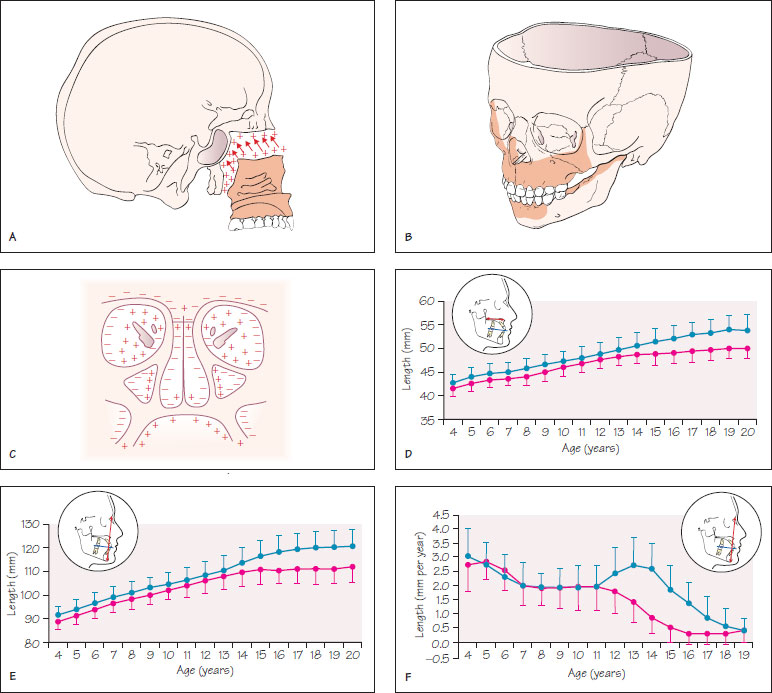4
Growth and development of the naso-maxillary complex
Figure 4.1 (A) Tension placed across the circum-maxillary sutures leads to bone deposition by intramembranous ossification and primary displacement of the maxilla. (B) Surface remodelling, by bone deposition and resorption can produce additive and substractive changes in the maxilla. The shaded areas are resorptive whereas the non-shaded areas are additive. (C) The palate descends as a result of growth due to surface remodelling. Bone is deposited on the oral aspect and resorbed from its nasal surface. This is responsible for an increase in the vertical size of the nasal cavity. +, areas of bone deposition; –, areas of bone resorption. (D) A distance curve for maxillary length showing the cumulative growth of the maxilla as a function of age. The blue line shows male and the magenta line female growth. The error bars represent the standard deviation of each mean value. Maxillary length was measured between ANS and PNS (see inset). (E) A distance curve for anterior facial height showing the cumulative growth in face height as a function of age. The blue line shows male and the magenta line female growth. The error bars represent the standard deviation of each mean value. Anterior face height was measured between nasion and menton (see inset). (F) A velocity curve for anterior facial height showing the average growth per year. The blue line shows male and the magenta line female growth. The error bars represent the standard deviation of each mean value. Anterior face height was measured between nasion and menton (see inset). Data for (D), (E), (F) taken from Bhatia and Leighton, 1993. A manual of facial growth. Oxford University Press.

The maxilla forms by intramembranous ossification, which first occurs within the maxillary process of the first pharyngeal arch at 8 weeks in utero. The maxilla is suspended from the undersurface of the anterior cranial fossa by the circum-maxillary sutures. The cartilaginous nasal septum, extending between the cranial base and nasal surface of the palate, is intimately related to the maxilla.
Implant studies show that on average the maxilla grows downwards and forwards from the anterior cranial base at approximately 50° to the sella–nasion line. However, there is tremendous individual variation with some having an almost horizontal, vertical or intermediate direction of growth.
Mechanism of maxillary growth
Processes involved in the growth of the maxilla include:
- Primary and secondary displacement;
- Intramembranous />
Stay updated, free dental videos. Join our Telegram channel

VIDEdental - Online dental courses


